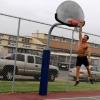An interesting open access paper was recently published on the effects of hyperbaric oxygen treatment on telomere length and cellular senescence in immune cells taken from blood samples. I use the word "interesting" quite deliberately, because that is exactly and all that this research is. The paper is appropriately formal and modest on that front, but this attitude doesn't extend to the rest of the publicity, unfortunately. When one runs a business based around offering hyperbaric oxygen treatment, one must make hay while the sun shines, and extract every last drop of marketing juice from every study funded. Hence there are media articles out there at the moment breathlessly telling us that hyperbaric oxygen treatment reverses aging. This is ridiculous, and only makes it harder for the better end of the industry to make progress.
Per the paper, hyperbaric oxygen treatment causes average telomere length to grow by ~20% and markers of cellular senescence to decrease by ~35% in populations of circulating immune cells. This doesn't tell us that hyperbaric oxygen treatment is an amazing rejuvenation therapy, any more than the NAD+ and mitochondrial function data for exercise tells us that exercise is an amazing rejuvenation therapy. In both cases we already know the bounds of the possible. We know that these interventions don't turn older people into notably younger people. If we're calling exercise and hyperbaric oxygen treatment rejuvenation therapies, then the term "rejuvenation therapy" is meaningless.
What this does reinforce is the point that peripheral blood immune cell parameters can be very disconnected from the overall state of aging. We know that telomere length as assessed in these cells is a truly terrible measure of aging. Circulating immune cells are prone to large variations in the pace of celular replication in response to circumstances. Immune cells replicate aggressively when provoked by the presence of pathogens or other issues requiring a coordinated immune response. Telomere length shortens with every cell division in somatic cells: in immune cells, telomere length thus has a very wide spread across individuals, varies day to day, is just as influenced by infection status and other environmental factors as it is by aging. It is just not all that helpful as a measure of aging, and downward trends with age are only seen in the statistics for large study populations.
It seems plausible that the same is true of cellular senescence in immune cells. Cells become senescent when they hit the Hayflick limit on cellular replication. Throughout much of life, the senescence of immune cells is likely more determined by replication pace (and thus immune challenges, the burden of infection) than by aging. And that is before we even get to the point that the authors of this paper used a less than standard measure of senescence, one for which it is possible to argue that it may or may not actually be representative of the burden of senescent cells in immune populations. Overall this data is all interesting, but I suspect that it tells us more about the poor relevance of the metrics chosen to anything other than the deeper aspects of immune function.
If hyperbaric oxygen treatment removed ~35% of senescent cells throughout the body, it would already be well known as a reliable therapy for arthritis, a way to reverse chronic kidney disease, a way to suppress inflammatory conditions, and an effective treatment for numerous chronic diseases of aging. In mice, removing a third of senescent cells via senolytic drugs produces reliably large and beneficial outcomes, while hyperbaric oxygen treatment does not. So clearly it is not globally clearing senescent cells - and nor should any responsible party be trying to present reductions in senescent immune cells as indicative of global senolytic effects throughout the body. What is observed here is an effect limited to the way in which the immune system is functioning. There is some evidence for hyperbaric oxygen treatment to improve resistance to infectious disease such as influenza, and that is interesting in and of itself, but I feel that much of what is going on here is an attempt by certain parties to jump onto the longevity industry bandwagon, rather than responsibly focusing on a realistic view of what can be achieved with their chosen intervention.
Hyperbaric oxygen therapy increases telomere length and decreases immunosenescence in isolated blood cells : a prospective trial
Hyperbaric oxygen therapy (HBOT) utilizes 100% oxygen in an environmental pressure higher than one absolute atmospheres (ATA) to enhance the amount of oxygen dissolved in body's tissues. Repeated intermittent hyperoxic exposures, using certain HBOT protocols, can induce physiological effects which normally occur during hypoxia in a hyperoxic environment, the so called hyperoxic-hypoxic paradox. In addition, it was recently demonstrated that HBOT can induce cognitive enhancements in healthy aging adults via mechanisms involving regional changes in cerebral blood flow. On the cellular level, it was demonstrated that HBOT can induce the expression of hypoxia induced factor (HIF), vascular endothelial growth factor (VEGF), and sirtuin (SIRT), stem cell proliferation, mitochondrial biogenesis, angiogenesis, and neurogenesis. However, no study to date has examined HBOT's effects on telomere length and senescent cell accumulation.
Thirty-five healthy independently living adults, aged 64 and older, were enrolled to receive 60 daily HBOT exposures. Whole blood samples were collected at baseline, at the 30th and 60th session, and 1-2 weeks following the last HBOT session. Peripheral blood mononuclear cells (PBMCs) telomeres length and senescence were assessed. Telomeres length of T helper, T cytotoxic, natural killer and B cells increased significantly by over 20% following HBOT. The most significant change was noticed in B cells. There was a significant decrease in the number of senescent T helpers by -37.30% post-HBOT. T-cytotoxic senescent cell percentages decreased significantly by -10.96% post-HBOT.
In conclusion, the study indicates that HBOT may induce significant senolytic effects including significantly increasing telomere length and clearance of senescent cells in the aging populations.
View the full article at FightAging






















































